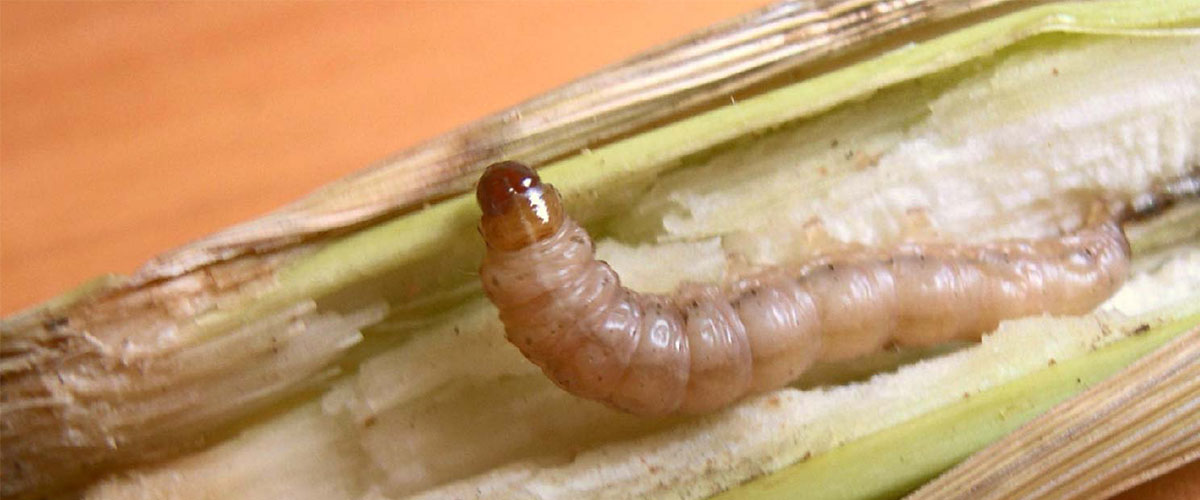Major insect pests that attack sorghum

Major insect pests that attack sorghum
- Stem/stalk borers
- Many types of stem borers affect sorghum in the field causing great yield loss.
- However, four types stem borers are common in Uganda in particular where their larvae are the destructive stage.
- These include the spotted stem borer, sugarcane borer, maize stalk borer and the pink borer.
Control
- Crop rotation
- Early planting on the onset of rains
- Planting Napier grass around the sorghum fields as a catch crop
- Intercropping sorghum with none host crops such as beans and cowpeas
- Spraying with an insecticide once every 2 weeks and integrated pest management is effective in reducing crop damage.
- Sorghum shoot fly

- The shoot fly, Antherigona soccata, is a widely distributed pest in the sorghum growing semi-arid agro-ecological zones of Uganda except in the cold highlands above 1800masl.
- The female shoot flies lay cigar-shaped eggs singly on the lower surface of the leaves, at the 1-7 leaf stage from 5 to 25 days after seedling emergence.
- The eggs hatch within 1- 2 days and the larvae moves and bores into the base of the shoot, damaging it to cause wilting and subsequent dead heart symptom.
- The plant may produce tillers as a survival mechanism in response to damage.
- Shoot fly population is normally high if sorghum is planed late (usually a month after the onset of rains).
- During off season the shoot fly survives on alternative hosts such as finger millet and maize.
Control
- Use of shoot fly resistant varieties.
- Early planting at the onset.
- Use of systemic insecticides such as Carbofuran 5G granules applied at the root base of the plants.
- Alternatively, spraying the leaves and shoots of seedlings with imidacloprid 70 WS (2gms/ kg) or Endosulfan 35 EC.
- Use a botanical insecticide Neem oil 2%.
- A Combination of the above as integrated pest management is effective in reducing crop damage.
- Sorghum midge

- Sorghum midge, Stenodiplosis sorghicola, is widely distributed in all sorghum growing areas of Uganda, except in the cold highlands above 1800masl.
- The female sorghum midge lays 30-120 eggs, which hatch within 2-3 days, in the flower spikelets.
- The larvae move and feed on developing ovary, preventing normal seed development. Larval period lasts 9-12 days and is the destructive stage of the pest that can cause up to 100% sorghum crop loss.
- Larvae pupate inside the spikelet and pupal period lasts 3-8 days.
- Before the adults emerge, the pupae move to the tip of the spikelet, and on emergence, the pupal case remains attached to the chaffy spikelet.
Control
- Early planting at the onset of rains to escape the sorghum midge population build up.
- Planting sorghum varieties with same maturity period at the same time within the communities.
- Sorghum that flowers later than the rest is exposed to higher populations of the sorghum midge for a longer period and suffers severe damage.
- Removing alternative hosts such as Johnson grass and Sudan grass to reduce on the initial early buildup of the pest.
- Field sanitation before the onset of the rains lowers the carry over effect of the diapausing larvae or pupae to subsequent seasons.
- Crop rotation with other none host crops.
- Land fallowing reduces the carry over and buildup of sorghum midge populations and use of resistant or tolerant sorghum varieties.
- Use of inorganic insecticides as the last resort to prevent severe damage can be done and a combination of the above sorghum midge control strategies as integrated pest management is effective in reducing crop damage.
- Bird damage in sorghum

- Birds are very destructive pests affecting sorghum productivity in Uganda.
- Several bird species are destructive but the Quelea quelea and the weaver birds are the most important.
- The Quelea quelea affects mainly the soft dough stage of especially the white/cream seeded varieties while the weaver birds affect the hard dough stage.
- Depending on the season the red seeded varieties may be less affected.
Farmers allege sorghum planted in the second rains is less affected by birds; a reason why many farmers growing lowland sorghum plant in the second rains.



